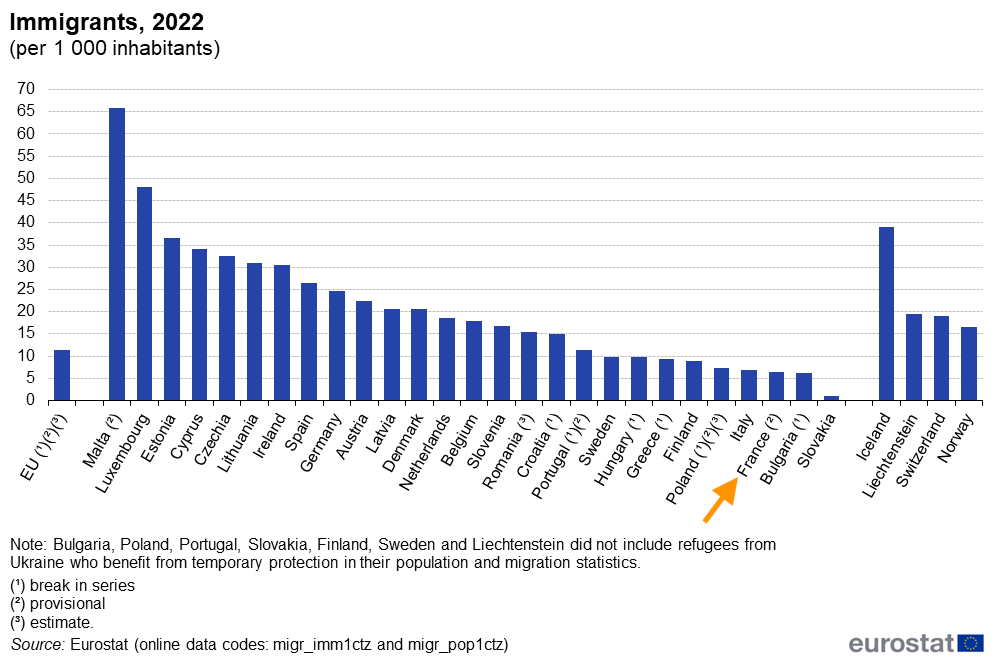According to demographer and immigration specialist François Héran, the French Prime Minister's statements about a "feeling of migratory submersion" are unfounded. Compared to other European nations, France admits relatively few immigrants.
French Prime Minister François Bayrou recently sparked indignation of part of the political class by stating that France was "approaching" a "feeling of submersion in terms of immigration." The use of the word "submersion" -- not insignificant -- is part of the vocabulary of the far-right National Rally party. Far from defending himself against this comparison with the far right, François Bayrou repeated his remarks the following day (on January 28) in the National Assembly, targeting Mayotte and certain other departments.
The Director General of the French Office for Immigration and Integration (OFII), Didier Leschi, criticized the term as improper and clumsy. "There is no migratory submersion, but there are places where the concentration of immigration poses significant social problems that must be resolved," he said.
So is the term exaggerated?
According to France’s National Institute of Statistics and Economic Studies (INSEE), Bayrou’s claim does not hold up. In 2023, France had 5.6 million foreign residents -- 8.2 percent of the total population, up from 6.5 percent in 1975. While the number has risen, such increases are common in developed countries.
"Immigration is perceived as uncontrolled, as a problem to solve, yet it is a normal demographic phenomenon," Jean-Christophe Dumont, head of the OECD's international migration division, told InfoMigrants in September. "The world population is increasing and therefore there are more and more immigrants and immigrants tend to go more and more to OECD countries.”
This is also the opinion of François Héran, sociologist, demographer, and professor at the Collège de France. "No indicator supports François Bayrou's claim about a supposed migratory submersion," he told InfoMigrants. "There is a rise in immigration, yes, but it is moderate. It is continuous, not exponential, it’s a linear increase" that is taking place everywhere in developed countries around the world.
"In reality," he added, "immigration has been increasing at the same rate for years, whether under the mandates of Jacques Chirac, Nicolas Sarkozy, François Hollande or Emmanuel Macron. There is no point in pointing the finger at the previous president by denouncing his migration record, this increase has nothing to do with French policies."
France welcomes few immigrants
Above all, François Héran explained, France welcomes few immigrants on its soil compared to other European countries. According to an average established by the OECD, foreigners settling each year -- for at least one year -- in a OECD country increase the total population on average up by 1 percent.
"France is well below this average: it is at 0.5 percent. Ahead of us, there is Germany at 0.6 percent, Sweden at 0.8 percent, Spain at 1 percent, Belgium at 1.1 percent, Portugal at 1.2 percent. We are not at the top of the chart, but rather at the bottom.”
Other indicators tell the same tale. "According to Eurostat, France is not the most welcoming country. It has a proportion of 13 percent of immigrants in its total population [i.e. foreigners, European or not, who have been living in a country other than their birth country for at least a year, editor's note] while Luxembourg has a rate of 49 percent, Malta 23 percent, Germany 18 percent. Here again, we are not at the top of the ranking," François Héran added.

Even the Prime Minister's reference to Mayotte does not seem to convince the demographer. "Yes, there is a high concentration of immigrants in certain territories, such as Mayotte, or in Ile-de-France, or in certain French border regions. But if these arrivals can create an emotion, they do not correspond to submersion in light of the figures taken as a whole."
In Mayotte, French authorities conduct frequent deportations to the neighboring Comoros. In 2023, around 24,000 people were expelled, similar to figures from previous years, including a smaller number of migrants from Africa’s Great Lakes region.
Read AlsoFrench minister says EU, UK need 'migration treaty' after Channel deaths
A feeling of 'invasion' that took hold in the 2000s
The fact remains that this "continuous" increase in immigration in rich countries provides fodder for certain racist theories, in particular that of the "great replacement" -- the notion that France’s native population would gradually be replaced by another, in this case, African populations and Muslims.
Despite the reality of the figures, François Bayrou's statements resonate as a political opening to the far right and they disturb a large part of the political class on the left. "It is not with a word like that" that the "electoral dynamic of the RN will be broken,” political scientist Jean-Yves Camus said on French television.
The president of the National Assembly, Yaël Braun-Pivet, said she would have "never made these remarks" which "embarrass" her. "We are talking about men and women, about our country, France which, by its history, by its geography, by its culture, has always welcomed and built itself with this tradition."
Read AlsoGermany: Debunking some of the AfD's statements regarding migration
